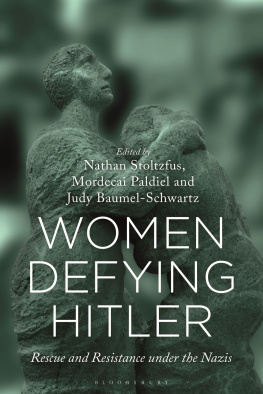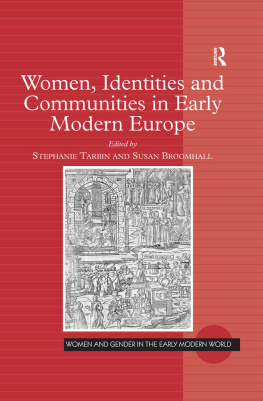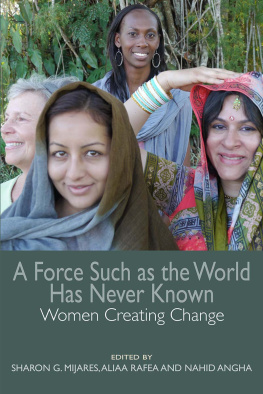Women Defying Hitler
Women Defying Hitler
Rescue and Resistance under the Nazis
Edited by Nathan Stoltzfus, Mordecai Paldiel, and Judy Baumel-Schwartz

Contents
To begin, special thanks is due to Volker Berghahn, emeritus historian of German and modern European history at Columbia University, for opening up space at Columbia University for our conference in October 2018 on the occasion of the seventy-fifth anniversary of the Rosenstrasse Protest. He genially put his time, resources, and organizational skills to the service of academic inquiry and discussion. We are also deeply grateful to Dorothy and Jonathan Rintels for endowing the Professorship in Holocaust studies in the Arts and Sciences and History Department which co-sponsored the conference with the Columbia History Department.
We are also deeply grateful to the German Consulate in New York, which sponsored an event in commemoration of the Rosenstrasse Protest on February 27, 2018, where we met survivors and descendants of the protest and the idea for a conference came to life with the invaluable support of German Consul David Gill. The German Consul granted crucial financial support in support of the conference and Mr. Gill generously attended the conference to give the opening address. Not to miss out our appreciation to the Columbia University Jewish Studies, and in particular the German Department with Mark Anderson, who was very helpful with opening Deutsches Haus for the conference at a minimum cost.
Thanks are also due to all the persons who attended our 2018 Columbia conference, some of whom followed this up with articles in this book. We mention them all in alphabetical order: Mark Anderson, Volker Berghahn, Renate Bridenthal, Elisheva Carlebach, David Gill, Susanne Heim, Marion Kaplan, Anne Nelson, Stanlee Stahl, and William Weitzerand yours truly, Nathan Stoltzfus and Mordecai Paldiel. Not to forget Judy Baumel-Schwartz, who accepted our invitation to co-edit this book, so that with her extensive scholarship, bolstered the emphasis on the role of gender in resisting the Nazi phenomenon.
We express heartfelt thanks to Danielle Wirsansky for applying some of her boundless energy to the project, in carefully reading all the articles for composition and style, before submitting them to the publisher.
Finally, speaking of the publisher, Rhodri Mogford and Laura Reeves, of Bloomsbury, stand out for their diligence, patience and understanding. Thanks to them, the production of this book proceeded along smooth lines and friendly cooperation, and they too deserve all of our thanks.
Confronting the Nazis
It is so crucial that we remember and that we illustrate how courageous people resist and how resistance is possible even in the darkest chapters of human history. It is particularly important in times when civil courage and the advocacy for freedom and individual rights worldwide are necessary.
Before I moved to New York a year ago I lived for almost 30 years in the borough of Mitte in the center of Berlin, a neighborhood which is shaped by the former, but to some extent also by returning, Jewish life in Berlin. A neighborhood where the signs of the happy times and the most terrible times of Jewry in Berlin can be seen everywhere. In the years when my children were much younger I used to take them to school. And every morning I walked by a rather unimpressive little dead end street between huge buildings of socialist architecture from the 60ies. Not much is left from the time before Berlin was destroyed on this little street which is called Rosenstrasse and only a few people recognize the monument in this little street. For today you will see a photo of this monument, if you open the program or invitation. And even less people know what it stands for. What courageous, fearless women achieved at this very place 75 years ago in the middle of the Nazis Reich. That is why conferences like yours are so important.
When the women went out on the streets shouting Give us our husbands back! they risked everything. We know confronting the Nazi-Regime could have resulted in prison and death. Nevertheless, those women never gave up. They expressed their anger and disagreement in a protest. It continued for days until the police, eventually, released their husbands. No one had believed that they would see their loved ones ever again, but the courage they showed in risking their own lives helped them to succeed in their goal.
This act of courage shows the power of love and the strength of solidarity. It also shows that never losing hope and standing together in difficult times can make unimaginable things happen.
What happened 75 years ago at the Rosenstrasse can inspire people all over the world, also in our respective countries. It should encourage us to stand up against racism, xenophobia, antisemitism and against those who advocate hatred in our societies. In doing so we risk so much less than the courageous women in Berlin.
Looking at the Rosenstrasse protests should also be a reminder and incentive for civil society and governments or multinational organizations to support brave people worldwide who stand up against injustice, the abuse of power and the denial of democracy, human rights and the rule of law. It is important that we show solidarity to those who risk their personal freedom and sometimes their life when they fight for justice and freedom.
Therefore, I am very grateful when you focus on the persecution, resistance and rescue of Jews and other minorities. And I am interested to hear more about recent research on the risks and dilemmas of resistance against the Nazi occupation in Europe.
It is the look back which often can guide us to do the right thing. To be able to focus clearly, we need research, scientific publication and teaching of our history, we need dedicated historians and scientists from other disciplines.
Nathan Stoltzfus, Mordecai Paldiel, and Judy Baumel-Schwartz
This book was conceived as a commemoration on its seventy-fifth anniversary of the German womens Rosenstrasse The escalation of popular protests against authoritarian repression in recent decades illustrates the continuing timeliness of that protest. To find a much broader context for this event the book identifies resistance and rescue in which women became involved both inside Germany under the Hitler dictatorship after 1933 and from 19389 in Nazi-occupied Europe. It does not survey all the ways people, especially women, found to defy Hitler but identifies some prominent case stories from among the many others who knew from the start that they were against what Hitler stood for.
The array of examples we characterize here, from open, largely spontaneous protests to organized, clandestine resistance, also reveals consequential differences in the ways the regime responded to different forms of opposition. Although many women did defy Nazism unobtrusively, while others frustrated Nazi plans by standing their ground, some were actively involved in attempts to undermine the Hitler dictatorship. If unable to conceal their defiance while focusing on resistance and rescue within their grasp, many of the women in this book were willing to openly identify themselves in acts of defiance, rather than remaining in a conspiratorial underground.
Womens protests in France and Germany show that open collective opposition that made limited demands within certain circumstances could be effective. The most critical intervention in the rescue of full German Jews was the Rosenstrasse Protest. In 1943, starting during the last days of February, the Berlin Gestapos Final Roundup seized up to 2,000 Jews married to non-Jews and imprisoned them in an administrative building in the heart of Berlin at Rosenstrasse 24, around the corner from Gestapo headquarters. The imprisoned Jews were almost all men married to non-Jewish women, who hurried to Rosenstrasse and began a protest that lasted a week, despite repeated orders from guards that they clear the streets or be shot. Heinrich Himmlers men knew this arrest as part of the elimination of Jews from Reich territory, which coincided with Berlin Gauleiter Joseph Goebbels resolve to clear the Reich capital of Jews by mid- or late-March, and the urgent demand from industries at Auschwitz for a quota of skilled workers that could be met only with intermarried Jews. But the women who set out to make a scene drew the attention of Joseph Goebbels, who wrote on March 6, 1943, that he had released the intermarried Jews because of the unpleasant scenes of those siding with the Jews.











